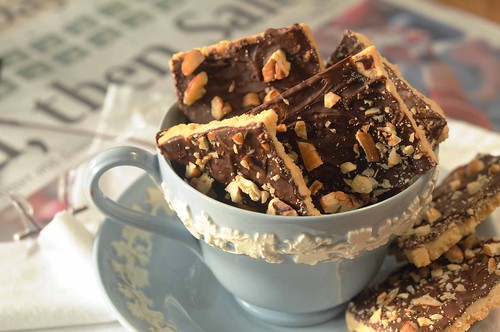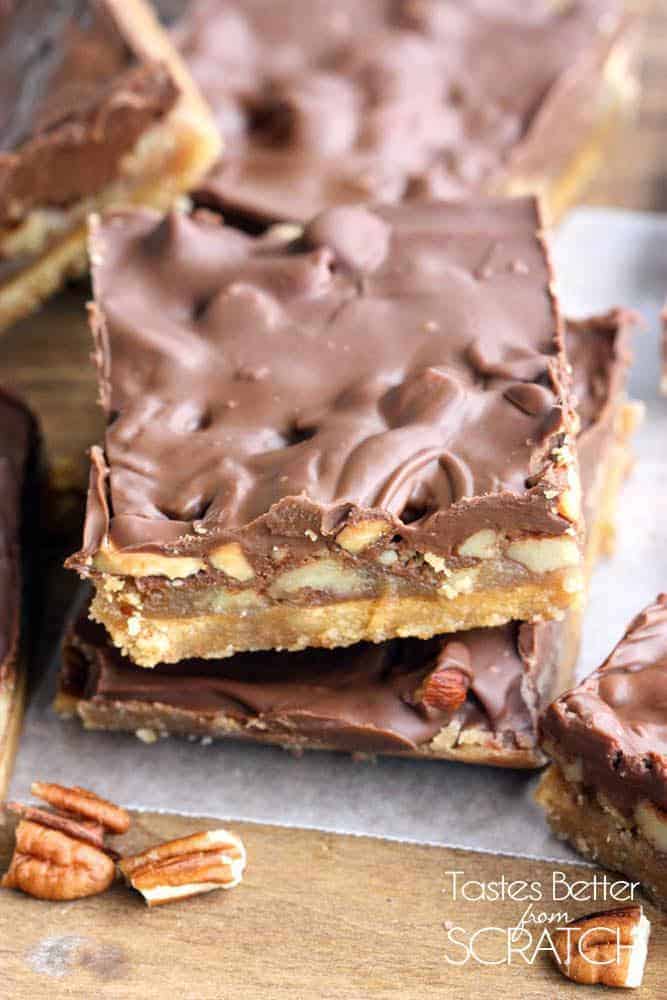Toffee Bars
- 8 Comments!

Toffee - Wikipedia. Toffee from the UK (a chewy variant) in cellophane wrapping. This article refers to the sweet. For the Premier League team known as "the Toffees" see Everton F. C. Toffee is a confection made by caramelizingsugar or molasses (creating inverted sugar) along with butter, and occasionally flour. The mixture is heated until its temperature reaches the hard crack stage of 1.
C (3. 00 to 3. 10 °F). While being prepared, toffee is sometimes mixed with nuts or raisins.
The toffee mixture will harden as these cool, transforming into a snappy, crunchy layer that holds everything together. Brown sugar cookie crust topped with chocolate, toffee bits, and pecans makes for rich-and-delicious Toffee Bars. A dense, buttery cookie with a hint of coffee forms a base for the soft, nutty topping. Finished with a sprinkling of sea salt, these bars offer a contemporary. Vosges Haut-Chocolat invites you to travel the world through chocolate.
Creation[edit]The process of making toffee requires the boiling of ingredients until the mix is stiff enough to be pulled into a shape which holds and has a glossy surface. The resulting mixture will typically be poured into a shallow tray and allowed to cool to form a slab.


- These cookie bars are soft, delicate, and chewy in the middle with a crispy outer edge. Coconut sugar lends a wonderful toffee flavour to these bars.
- A dash of cinnamon and chewy toffee make this moist apple cake really special. Great served as a dessert with custard or in slices with a cup of something hot.
- This salty-sweet version of a shortbread cookie, packed with chocolate chips and brown sugar, is best when served warm. From the book "Mad Hungry," by Lucinda Scala.
- This is an easy to make but wonderfully delicious treat. We pack them in tins and give as gifts during the holidays. Use your favorite nuts to top the cookies.
- After I finish my leftover pie my husband has already requested these delicious Graham Cracker Toffee Bars. These little beauties couldn’t be easier to make.
Different mixes, processes, and most importantly, temperatures, will result in different textures and hardnesses, from soft and often sticky to a hard, brittle material. A brown color, and smoky taste, is imparted to the toffee by the caramelization of the sugars. Variants and applications[edit]A popular variant in the US is English toffee, which is a very buttery toffee often made with almonds. It is available in both chewy and hard versions. Heath bars are a type of confection made with an English toffee core.
Although named English toffee it bears little resemblance to the wide range of confectionery known as toffee currently available in the United Kingdom. However, one can still find this product in the UK under the name "buttercrunch." [1]Another variant is honeycomb toffee, which is an aerated version with bubbles introduced by adding baking soda and vinegar while mixing. These react to form carbon dioxide, which is trapped in the highly viscous mixture.
In the UK and Canada, the most well known honeycomb confection is the Crunchie bar. A similar Australian chocolate bar is the Violet Crumble. In New Zealand, toffee flavoured ice cream is called hokey pokey. A particular application of toffee is in toffee apples, sometimes called candy apples, which are apples coated with hard toffee mounted on sticks.
Toffee apples are similar to taffy apples and caramel apples, which are both covered in caramel. Toffee used in confectionery can be mixed with many different ingredients to produce a variety of flavors: rum and butter, chocolate covered, vanilla and chocolate, rum and raisin, raspberry, and honeycomb. Etymology[edit]The origins of the word are unknown. Food writer Harold Mc. Gee claims it to be "from the Creole for a mixture of sugar and molasses", but which creole language is not specified.[2] The Oxford English Dictionary dates the first publication of the word to 1. English dialectical words.[3][4]See also[edit]References[edit]^Hughes, Glyn Lloyd (2. The Foods of England.
Tomato. p. 2. 65. ISBN 9. 78. 09. 55. Mc. Gee, Harold (2. 1800 Calories there. On Food and Cooking: The Science and Lore of the Kitchen. Scribner. p. 6. 50. ISBN 9. 78. 06. 84. Oxford English Dictionary Second Edition 1.
Oxford English Dictionary Second Edition 1.